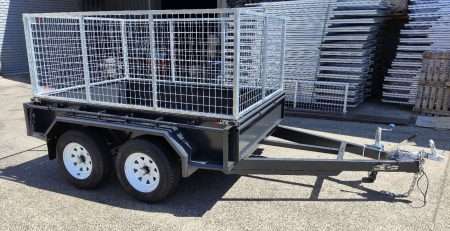
Unleash the Power: Choosing the Perfect Tandem Trailer Frame
Understanding Tandem Trailers
Tandem trailers are a popular choice for individuals and businesses that require a reliable and efficient method of transporting heavy loads. By utilising two axles instead of one, tandem trailers offer enhanced stability, increased load capacity, and improved weight distribution. Let’s delve into the details of what tandem trailers are and the benefits they provide.
What Are Tandem Trailers?
Tandem trailers, also known as dual-axle trailers, are trailers equipped with two axles and four wheels. Unlike single-axle trailers, which have only one axle and two wheels, tandem trailers provide superior load-bearing capabilities and enhanced towing stability. The additional axle allows for a higher gross weight rating, enabling the trailer to carry heavier loads.
With the ability to handle substantial weight, tandem trailers are commonly used for various applications, such as transporting boats, RVs, construction equipment, and other heavy items. They are particularly well-suited for hauling large and bulky loads due to their increased weight capacity and stability.
The Benefits of Tandem Trailers
Tandem trailers offer several advantages over their single-axle counterparts. Here are some key benefits of using tandem trailers:
Stability and Handling: The presence of two axles provides increased stability and better weight distribution compared to single-axle trailers. This results in improved towing performance, especially at higher speeds. Tandem trailers offer a smoother ride and greater control, reducing the chances of swaying or fishtailing during transportation.
Increased Load Capacity: Tandem trailers have a higher weight capacity compared to single-axle trailers. With two axles sharing the load, the weight is evenly distributed, allowing the trailer to support and transport heavier loads. This added load capacity makes tandem trailers an ideal choice for hauling substantial items that exceed the capabilities of single-axle trailers.
To ensure safe and efficient towing with tandem trailers, it’s essential to consider factors such as tandem trailer weight capacity, tandem trailer dimensions, and tandem trailer hitch compatibility. Additionally, complying with tandem trailer regulations regarding legal weight limits is crucial for maintaining safety on the road.
By understanding the concept of tandem trailers and recognising their benefits, you can make an informed decision when selecting a trailer that meets your hauling requirements. Whether you need to transport heavy machinery, recreational vehicles, or other sizable loads, tandem trailers provide the durability, stability, and load capacity necessary to get the job done efficiently.
Tandem Trailer Frame Design
When it comes to tandem trailers, understanding the design of the trailer frame is essential. The tandem trailer frame consists of two or more axles arranged in series, providing enhanced stability and weight distribution compared to single-axle trailers (DMV Virginia). In this section, we will explore the components of a tandem trailer frame and the importance of weight distribution.
Components of a Tandem Trailer Frame
A typical tandem trailer frame consists of the following components:
Main Rails: The main rails form the foundation of the trailer frame, providing structural support and stability. These rails are usually made of high-strength steel and are designed to withstand the weight and stress of the load being carried.
Cross Members: Cross members are horizontal beams that connect the main rails, providing additional support and rigidity to the trailer frame. These cross members are typically spaced evenly along the length of the trailer and contribute to its overall strength.
Axles: Tandem trailers have two or more axles positioned close together. The axles are attached to the main rails and support the weight of the trailer and its cargo. Each axle is equipped with suspension systems, brakes, and tyres.
Suspension Systems: The suspension systems of tandem trailers help absorb shocks and vibrations during travel, providing a smoother ride. Common types of suspension systems include leaf springs, torsion axles, and air ride suspension.
Brakes: Tandem trailers are equipped with braking systems to ensure safe and controlled stopping. These systems can include electric brakes, hydraulic brakes, or surge brakes, depending on the trailer’s design and intended use.
Tyres and Wheels: The tyres and wheels of a tandem trailer are crucial for supporting the weight of the trailer and providing traction on the road. Proper tyre selection and maintenance are essential for safe towing.
Weight Distribution in Tandem Trailers
One of the key advantages of tandem trailers is their ability to distribute weight more evenly compared to single-axle trailers. The tandem axle design helps prevent overloading of individual axles and tyres, reducing the risk of tyre blowouts and improving overall safety (Big Tex Trailer World).
The weight distribution in a tandem trailer is achieved through the positioning of the axles. The distance between the centre points of the first and last axles in a tandem trailer frame should not exceed 40 feet (DMV Virginia). This spacing ensures that the load is evenly distributed across the axles, minimising the strain on individual components.
Proper weight distribution is crucial for maintaining control and stability while towing. It helps prevent excessive strain on the trailer frame, axles, and tyres, reducing the risk of mechanical failures and accidents. When loading a tandem trailer, it’s important to distribute the weight evenly between the axles and secure the load to prevent shifting during transportation.
By understanding the components of a tandem trailer frame and the significance of weight distribution, you can make informed decisions when choosing and operating a tandem trailer. Whether you’re hauling heavy equipment or transporting goods, a well-designed tandem trailer frame provides the stability and durability necessary for safe and efficient towing.
Advantages of Tandem Axles
Tandem axle trailers, equipped with two axles positioned close together, offer several advantages over their single-axle counterparts. Let’s explore the benefits of tandem axles, including enhanced stability and handling as well as increased load capacity.
Stability and handling
One of the primary advantages of tandem axles is the improved stability and handling they provide. The presence of an additional axle promotes better weight distribution across the trailer, reducing the chances of swaying or fishtailing. This is especially noticeable at higher speeds, where the increased stability of tandem axles enhances the overall towing experience (Big Tex Trailer World).
The two axles work in harmony to support the trailer’s weight, minimising the impact of uneven road surfaces. This results in a smoother ride, reduces the risk of cargo damage, and improves overall safety. Tandem axles’ stability ensures a more controlled and secure towing experience whether you’re towing a boat, RV, or piece of construction equipment.
Increased load capacity
Tandem axle trailers are renowned for their increased load capacity compared to single-axle trailers. The presence of two axles allows for a higher weight rating, enabling you to transport heavier loads with ease. The weight is distributed more evenly across the axles, reducing the strain on individual components and enhancing the trailer’s overall durability and performance.
The increased load capacity of tandem axles makes them ideal for hauling large items such as boats, RVs, and construction equipment. You can confidently transport heavy cargo, knowing that the tandem axles can handle the weight distribution effectively. This versatility and strength make tandem axle trailers a popular choice for those who require robust hauling capabilities.
By opting for tandem axles, you gain the advantages of enhanced stability, better handling, and increased load capacity. These features make tandem axle trailers the preferred choice for hauling heavier loads and navigating various road conditions. Whether you’re transporting equipment to a job site or embarking on a cross-country adventure, tandem axle trailers deliver the reliability and performance you need.
Safety Features of Tandem Trailers
When it comes to towing, safety should always be a top priority. Tandem trailers are equipped with specific safety features to ensure a secure and reliable towing experience. In this section, we will explore two essential safety features of tandem trailers: breakaway switches and licence plate requirements.
Breakaway Switches
Tandem trailers are required to have a breakaway switch as a safety measure in case the trailer becomes disconnected from the towing vehicle. This switch activates the trailer’s brakes, bringing it to a controlled stop and preventing it from rolling away uncontrollably. The breakaway switch is connected to the towing vehicle and attached to the trailer frame.
The breakaway switch is designed to activate the trailer brakes if it detects a disconnection or a break in the towing system. This ensures that the trailer remains stationary and does not pose a danger to other vehicles on the road. It is essential to regularly check the condition and functionality of the breakaway switch to ensure its effectiveness in case of an emergency.
Licence plate requirements
Tandem trailers, like any other trailer, must have a conspicuously displayed licence plate. This plate serves as a unique identifier for the trailer and is required to be placed in a position where it is clearly visible. Displaying a licence plate on the tandem trailer helps law enforcement and other drivers identify the trailer and its owner.
By adhering to licence plate requirements, you not only comply with the law but also contribute to road safety and accountability. It is important to ensure that the licence plate is securely attached to the trailer and is easily readable. Regularly check the licence plate to ensure it is not damaged or obscured.
In addition to breakaway switches and licence plate requirements, tandem trailers may also be equipped with other safety features, such as electric brakes. Electric brakes improve braking performance and allow for safer towing, especially when carrying heavier loads (Curt Manufacturing). Always familiarise yourself with the safety features specific to your tandem trailer and ensure they are properly maintained.
To ensure safe towing, it is important to follow all safety guidelines and regulations. Properly connecting safety devices, maintaining their functionality, and complying with licence plate requirements will contribute to a secure towing experience. By prioritising safety, you can unleash the full potential of your tandem trailer while keeping yourself and others on the road safe.
Considerations for Tandem Trailer Weight Limits
When it comes to tandem trailer frames, it’s essential to understand and adhere to the legal weight limits for tandem trailers. These limits vary depending on the state and the type of road the truck is travelling on. For instance, in many states, the limit for tandem axles on a truck or tractor-trailer combination is 34,000 pounds. Exceeding these weight limits can result in fines and penalties, and it can also cause damage to roadways and bridges.
The weight limits for tandem trailer frames are in place to ensure safe and efficient transportation of goods. They help prevent excessive wear and tear on the truck’s tyres and brakes, as well as maintain the structural integrity of the trailer frame. It is crucial for truck drivers and trucking companies to be aware of these weight limits to comply with the law and avoid penalties and fines.
The weight capacity of a tandem trailer frame depends on various factors, including the frame type, axle rating, and suspension system. Higher-capacity tandem trailer frames can typically handle loads ranging from 7,000 to 25,000 pounds or more (Curt Manufacturing). It’s important to note that exceeding the weight capacity of a tandem trailer frame can compromise its stability and safety.
Compliance with weight limits is crucial for ensuring the safety of the truck, its occupants, and other road users. It also helps prevent unnecessary damage to the trailer frame and its components. Regular inspections and maintenance of the tandem trailer frame are necessary to ensure that it remains in optimal condition and can handle the intended load.
By understanding and adhering to the legal weight limits for tandem trailer frames, truck drivers and trucking companies can operate safely and efficiently while complying with the law. It is the responsibility of everyone involved in the transportation process to prioritise safety and maintain compliance to prevent accidents, damage, and legal consequences.
Ensuring Towing Safety
When it comes to towing a tandem trailer, safety should always be a top priority. Properly connecting safety devices and ensuring their functionality is essential to preventing accidents and ensuring a smooth towing experience.
Safety Devices for Tandem Trailers
According to the Federal Motor Carrier Safety Administration (FMCSA), every full trailer must be coupled to the frame, or an extension of the frame, of the towing vehicle with one or more safety devices to prevent the towed vehicle from breaking loose in the event the tow bar fails or becomes disconnected. These safety devices are designed to keep the trailer connected to the towing vehicle, minimising the risk of accidents and enhancing overall towing safety.
One commonly used safety device is a breakaway switch, which activates the trailer’s brakes in the event of a disconnection. This ensures that the trailer comes to a controlled stop instead of continuing to roll freely. Breakaway switches are an essential safety feature for tandem trailers, providing an additional layer of protection and peace of mind.
Proper Connection of Safety Devices
To ensure optimal towing safety, it is crucial to properly connect the safety devices on your tandem trailer. The safety device should be connected to both the towed and towing vehicles, as well as the tow bar, in a manner that prevents the tow bar from dropping to the ground in the event it fails or becomes disconnected (FMCSA).
If the drawbar design includes bolts, connecting pins, or similar devices located at or near the midpoint of the drawbar, safety devices must extend from the frame of the towed or towing vehicle to a point beyond these connection points. This ensures that the safety devices provide sufficient support and prevent the drawbar from dropping to the ground if it fails or becomes disconnected (FMCSA).
In the case of an extendable drawbar or reach, if separate safety devices are used for the front and rear of the drawbar, measures must be in place to ensure that the drawbar will not separate at the movable portion. The use of welded tube stops with welds that exceed the impact forces associated with the drawbar extending suddenly with a fully loaded trailer attached can satisfy the safety requirements (FMCSA).
By ensuring the proper connection and functionality of safety devices on your tandem trailer, you can significantly enhance towing safety and minimise the risk of accidents. Regularly inspect and maintain these safety devices to ensure they are in good working condition. Remember, towing safety is a shared responsibility, and taking the necessary precautions helps protect not only yourself but also other road users.
Guidelines for Tandem Trailer Drawbar Design
When it comes to designing the drawbar for a tandem trailer, certain guidelines must be followed to ensure safety and proper functionality. The drawbar is an essential component that connects the trailer to the towing vehicle, and it must be designed with safety measures in mind.
Safety Measures for Drawbar Connections
According to the Federal Motor Carrier Safety Administration (FMCSA), every full trailer must be coupled to the frame, or an extension of the frame, of the towing vehicle with one or more safety devices to prevent the towed vehicle from breaking loose in the event the tow bar fails or becomes disconnected. These safety devices should be connected to both the towed and towing vehicles, as well as to the tow bar itself, in a manner that prevents the tow bar from dropping to the ground if it fails or becomes disconnected (FMCSA).
To meet these requirements, separate safety devices can be used at the front and rear of the drawbar. These devices should be attached to the drawbar and the vehicles in a way that prevents the drawbar from dropping to the ground in the event of a failure or disconnection (FMCSA). If the drawbar design includes bolts or connecting pins located at or near the midpoint of the drawbar, beyond the attachment points for the safety chain, the safety devices should extend from the frame of the towed or towing vehicle to a point beyond these bolts or pins (FMCSA).
Extending Drawbars and Safety Devices
In the case of an extendable drawbar or reach, it is crucial to ensure that the drawbar will not separate at the movable portion. If separate safety devices are used for the front and rear of the drawbar, measures should be taken to prevent separation at the movable portion. One way to achieve this is by using welded tube stops. These tube stops act as a means to prevent the drawbar from extending suddenly with a fully loaded trailer attached. To meet safety standards, the welds on the tube stops must have an ultimate strength that exceeds the impact forces associated with the drawbar extending suddenly with a loaded trailer.
By adhering to these guidelines for tandem trailer drawbar design, you can ensure the safety and stability of your trailer during transportation. It is important to consult local regulations and standards to ensure compliance with specific requirements in your area. Remember, the safety of your trailer and the vehicles sharing the road depends on the proper design and implementation of the drawbar and safety devices.
Author
I am Rahatul Ashiq Tamal. Another author of Muscle Trailers. Muscle Trailers is a well-known trailer brand in Sydney, Melbourne & Adelaide

How to Mount a Spare Tire on Your Trailer: A Simple Step-by-Step Guide
Trailer service centers receive over 1 million phone calls and 1.3 million emails each year about trailer maintenance problems....

How to Fix RV Roof Leaks: Simple Roof Leak Detection Guide for Beginners
Did you know DIY RV roof repairs can cost under $50? But undetected leaks could lead to substantially higher repair...

Starting a Food Truck Business in Australia: From Trailer Selection to Launch
The Australian mobile food market has evolved into a billion-dollar industry. This makes a food truck...
